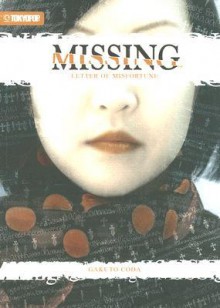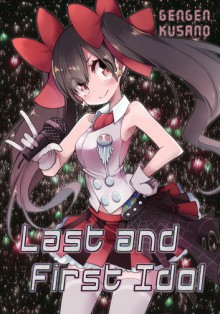
The Literature Club is back the way it was, for the most part - the main difference is that Ayame is still around, still nonhuman but much less powerful, and magically tied to Utsume by the events of the previous book. However, now Aki is having supernatural problems of her own. There's an urban legend about a cursed fax, a chain letter that the recipient receives for several days in a row and must send on in the same order if they want to avoid dying. It seems that the fax is real, and Aki has just begun receiving it. Not only is it creepy, arriving out of the blue at 2 AM, it's somehow causing Aki actual physical harm. The paper cut she got from the first fax showed signs of infection only a few hours later.
At the same time, there are rumors going around at school that there's a pack of wild dogs loose in the area. One of the teachers was bitten, and signs of the dogs can be found all over the school grounds, although no one has actually seen one of the dogs. Yomiko, the school witch, freaks out both Ryoko and Aki, warning Aki that she will be torn apart and eaten by dogs that no one can see. Somehow the Literature Club has to figure out what's going on and save Aki before it's too late.
If you haven't read the first book in this series, Missing: Spirited Away, I'd recommend starting there. Although these two books deal with entirely different supernatural beings, Missing: Letter of Misfortune references a lot of characters and events from the first book and doesn't devote a lot of time to explaining things for the benefit of newbies to the series. The entire Literature Club is back, of course, but so are Ayame, Yomiko, Jinno, and the men in black. The first book also mentioned something about Aki that turned out to be extremely important in this book.
As far as its supernatural aspects went, I liked this book a good deal more than the first. The cursed chain letter, demon summoning via fax, the invisible dogs - all of it was much more my jam than the fairy-like "spirited away" stuff in the first book. Aki was also my favorite character in the first book, so I was looking forward to a book that focused on her.
Unfortunately, that's one of the areas where this fell kind of flat. Although there were scenes from Aki's POV, for some reason it was harder to connect to her this time around. It also seemed like Coda had forgotten certain aspects of her character that he'd established in the first book. Yes, she was still cold and sharp on the outside and fragile and lonely on the inside, but all that stuff about her secretly being in love with Utsume seemed to be absent. I mean, I didn't entirely mind that, except that it introduced a few plot holes.
I distinctly remember Aki being jealous of Ayame in the first book. Her hidden feelings for Utsume and jealousy towards Ayame should have become an issue in this book, especially during the climactic battle, and yet none of that ever came up. It was as though those feelings had never existed and Utsume was just another friend of Aki's in the Literature Club. Heck, Ryoko was depicted as being more important to Aki than any of the other members of the club.
I really enjoyed the creepy scenes inside Aki's apartment, and the bit with the sender of the cursed fax reminded me a little of that scene with the tiny dinosaurs in the first Jurassic Park movie. Unfortunately, the story was a bit bogged down by Utsume's frequent lecturing. He gave the Literature Club a multi-page lecture on magic - granted, it contained useful information that both they and the reader needed to know, but it made Utsume seem decades older than his friends. Utsume even interrupted the climactic final battle to announce that he was going to give another lecture. Again, it turned out to be a useful lecture, but it made for a weird and slightly ridiculous moment.
Just like I had trouble following the events at the very end of the first book, I also had a little trouble figuring out what was going on at the end of this one. Some of the things Yomiko said didn't make much sense - I don't know if it's because of the translation, or if it was one of those things that would eventually have been cleared up by a later book in the series. Since none of the later books were ever translated and published, I guess I'll never know.
It's sad because, despite my complaints, I'd definitely continue on with this series if I could. I'd have loved to see what else Coda had planned for these characters. Utsume and Aki were the only characters that the men in black had identified as having some kind of connection to supernatural beings, but I recall Yomiko saying something intriguing about Toshiya that could potentially have been the focus of one of the series' books.
Even though I'll likely never get to read more of this series, I'm still glad I read these first two books. They were interesting and a nice change of pace from vast quantities of "reincarnated as a [random thing] in another world" Japanese light novels currently getting licensed and translated.
Additional Comments:
There were some glaring translation and editing issues. A couple of the worst ones:
"And slowly, the cursed child emerged." (101)
It's possible that this was an accurate translation, but I strongly suspect that this sentence was actually supposed to be "And slowly, the cursed fax emerged." A child did not emerge, Sadako-like, from the fax machine.
"The spell will not work if it is doesn't use the same base knowledge." (203)
I wonder, did Tokyopop's 2008 novels have more typos? I don't recall Missing: Spirited Away having similarly glaring errors.
Extras:
An excerpt from the third book in Coda's Missing series. I didn't bother to read it - what's the use, when the book was never published?
There was also an afterword by Coda, in which he mentioned that a friend of his had accused him of ripping off the Men in Black movie after hearing about the men in black he included in his books.
(Original review posted on A Library Girl's Familiar Diversions.)

 Log in with Facebook
Log in with Facebook 









